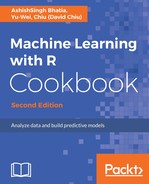Ensemble learning is a method for combining results produced by different learners into one format, with the aim of producing better classification results and regression results. In previous chapters, we discussed several classification methods. These methods take different approaches, but they all have the same goal, that is, finding an optimum classification model.
However, a single classifier may be imperfect, as it misclassify data in certain categories. As not all classifiers are imperfect, a better approach is to average the results by voting. In other words, if we average the prediction results of every classifier with the same input, we may create a superior model compared to using an individual method.
In ensemble learning, bagging, boosting, and random forest are the three most common methods:
- Bagging is a voting method, which first uses Bootstrap to generate a different training set, and then uses the training set to make different base learners. The bagging method employs a combination of base learners to make a better prediction.
- Boosting is similar to the bagging method. However, what makes boosting different is that it first constructs the base learning in sequence, where each successive learner is built for the prediction residuals of the preceding learner. With the means to create a complementary learner, it uses the mistakes made by previous learners to train the next base learner.
- Random forest uses the classification results voted from many classification trees. The idea is simple; a single classification tree will obtain a single classification result with a single input vector. However, a random forest grows many classification trees, obtaining multiple results from a single input. Therefore, a random forest will use the majority of votes from all the decision trees to classify data or use an average output for regression.
- Stacking or Super Learner algorithm multiple models are used and stacked over one another, predictions are passed from one layer to another and to the top layer. It is a loss-based supervised learning method.
In the following recipes, we will discuss how to use bagging and boosting to classify data. We can then perform cross-validation to estimate the error rate of each classifier. In addition to this, we'll introduce the use of a margin to measure the certainty of a model. Next, we will cover random forests, similar to the bagging and boosting methods, and introduce how to train the model to classify data and use margins to estimate the model certainty. Lastly, we'll demonstrate how to estimate the error rate of each classifier, and use the error rate to compare the performance of different classifiers.
